Field Measurements and Analysis on Temperature, Relative Humidity, Airflow Rate and Oil Fume Emission Concentration in a Typical Campus Canteen Kitchen in Tianjin, China
Abstract
1. Introduction
2. Method
2.1. Site Selection
2.2. Test Scheme
- (1)
- Measuring points of exhaust fume system: To assess the actual working status of the exhaust fume system, we arranged the measuring points according to the working procedure of the exhaust fume system, including capture point1, oil fume source2, hood face3, air inlet in hood4, discharge outlet5 and system energy consumption6.
- (2)
- As shown in Figure 1, point 1 was located at the outer edge of the stoves farthest from the air inlet in the hood to monitor whether it met the minimum air velocity required to capture cooking pollutants into the hood [27]. Point 2 was located at 0.5 m [28] above the stoves to measure the oil fume emission concentration under different cooking styles. Point 3 was located at the hood face to measure the air velocity of the hood face. Measuring point 4 was located at the connecting exhaust hood and air duct to measure the exhaust airflow rate during the hood working. Point 5 was set at the outdoor discharge outlet to measure the oil fume concentration emitted outdoors. Point 6 was located at the purifying equipment to get the energy consumption of the exhaust fume system.
- (3)
- Measuring points of the indoor environment: The measuring points of the indoor environment included cooking zone7 and the indoor area8. We set points 7 at 0.5 m away from the stoves and 1.5 m away from the floor [29] to study the temperature and humidity in the chef’s breathing area. According to GB/T18883 [30], for a 70 m2 kitchen, point 8 should be set with 5 points, which were distributed in quincunx, greater than 0.5 m from the wall, and height 0.5 m–1.0 m.
- (4)
- Measuring points of the makeup air system: The measuring points of the natural makeup air9 and the mechanical makeup air10 were considered. Point 9 was located at the door connected to the adjacent room; point 10 was located at the ceiling air outlet. Point 10 was not tested because the mechanical ventilation system was not turned on during the test.
- (5)
- Measuring points of the outdoor environment: It was arranged at 0.5 m away from the kitchen exterior wall, 0.8–1.8 m above the ground, and with no direct sunlight.
2.3. Measurement Uncertainty
2.4. Questionnaire
3. Results and Analysis of the Filed Measurements
3.1. Operation Status of the Test Area
3.2. Indoor Environment of Canteen Kitchen
3.2.1. Seasonal Variation of the Temperature and Relative Humidity
3.2.2. Temperature, Relative Humidity and Air Velocity on Typical Test Day
3.2.3. Effect of Stoves Status on Temperature and Relative Humidity
3.2.4. Evaluation of Indoor Thermal Comfort in Canteen Kitchen
3.3. Results and Analysis of the Questionnaire
3.3.1. Chefs’ Satisfaction with Thermal Comfort in the Canteen Kitchen
3.3.2. Chefs’ Sensation of Indoor Air Quality in the Commercial Kitchen
3.4. Exhaust Fume System
3.4.1. Temperature
3.4.2. Air Velocity and Airflow Rate
3.4.3. Oil Fume Emission Concentration
- (1)
- Indoor oil fume generation—observed value
- (2)
- Oil fume emission concentration at discharge outlet-test value
3.4.4. Energy Consumption Analysis of Exhaust Fume System
3.5. Discussion
4. Conclusions
- (1)
- The temperature in the canteen kitchen varied with the seasons. With 64.88% and 76.92% of the working time in the cooking zone being in the acceptable range (18–32 °C) in spring and autumn, respectively. In winter, the temperature was the lowest. The temperature in the cooking zone was the highest in summer, with about 82.92% of the working hours above the acceptable range.
- (2)
- The indoor air environment quality was affected by the cooking methods. When four stoves were used simultaneously, the cooking methods of four stoves were stir-frying or frying, the temperature of the cooking zone was 4.30 °C or 4.70 °C higher than that of three or two stoves used to stir-fry or fry, respectively. Therefore, chefs can alleviate the overheating of the cooking zone during the cooking process by avoiding cooking stir-fried or fried dishes simultaneously. In addition, the difference from the previous study result, the changing trend of the temperature and the relative humidity were opposite. It may be due to the traditional cooking methods of the Chinese canteen kitchen.
- (3)
- The questionnaire results were consistent with the test results. The chefs’ thermal sensations varied with the season. In summer, 83.33% of chefs felt hot. Most chefs’ wet sensations in the four seasons were neutral. In addition, there were 83.33% of the chefs felt the fume overflow from the exhaust hood during the cooking process, 83.33% of the chefs could sense the fume in the cooking area, and 69.41% of the chefs felt the noise generated by the exhaust fume system.
- (4)
- The exhaust fume system of the canteen kitchen was operated under the air velocity of 9.18 ± 1.60 m/s, and its exhaust airflow rate was 10,634.80 ± 189.30 m3/h, which was lower than the minimum exhaust airflow rate of 12,312 m3/h. This was probably the reason why the chefs felt the fume overflow from the exhaust hood.
Author Contributions
Funding
Institutional Review Board Statement
Informed Consent Statement
Data Availability Statement
Conflicts of Interest
References
- China Chain Store & Franchise Association. 2021 China Chain Catering Industry Report [R/OL]. Available online: http://www.ccfa.org.cn (accessed on 7 May 2022).
- National Bureaue of Statistics. Annual Number of Employees in Catering Industry in 2020 [EB/OL]. Available online: https://data.stats.gov.cn/easyquery.htm?cn=C01 (accessed on 7 May 2022).
- Shen, C. Survey Study on Exhaust Fume Systems and Exhaust Air Rate of Commercial Kitchen. Master’s Thesis, Tianjin University, Tianjin, China, 2020. [Google Scholar]
- Alama, M.S.; Sharmab, M.; Salvea, U.R. Assessment of thermal comfort in a hot and humid indoor built environment of a kitchen at a university canteen. Work A J. Prev. Assess. Rehabil. 2022, 72, 189–199. [Google Scholar] [CrossRef] [PubMed]
- Rahmillah, F.I.; Tumanggor, A.H.; Sari, A.D. The analysis of thermal comfort in kitchen. IOP Conf. Ser. Mater. Sci. Eng. 2017, 215, 012033. [Google Scholar] [CrossRef]
- Simone, A.; Olesen, B.W.; John, L.S.; Watkins, A.W. Thermal comfort in commercial kitchens (RP-1469): Procedure and physical measurements (Part 1). HVACR Res. 2013, 19, 1001–1015. [Google Scholar] [CrossRef]
- Giwa, S.O.; Nwaokocha, C.N.; Sharifpur, M. An appraisal of air quality, thermal comfort, acoustic, and health risk of household kitchens in a developing country. Environ. Sci. Pollut. Res. 2022, 29, 26202–26213. [Google Scholar] [CrossRef]
- Wang, L.; Xiang, Z.; Stevanovic, S.; Ristovski, Z.; Salimi, F.; Gao, J.; Wang, H. Role of Chinese cooking emissions on ambient air quality and human health. Sci. Total Environ. 2017, 589, 173–181. [Google Scholar] [CrossRef]
- Liu, S.; Cao, Q.; Zhao, X.; Lu, Z.; Deng, Z.; Dong, J.; Lin, X.; Qing, K.; Zhang, W.; Chen, Q. Improving indoor air quality and thermal comfort in residential kitchens with a new ventilation system. Build. Environ. 2020, 180, 107016. [Google Scholar] [CrossRef]
- Liu, S.; Dong, J.; Cao, Q.; Zhou, X.; Li, J.; Lin, X.; Qing, K.; Zhang, W.; Chen, Q. Indoor thermal environment and air quality in Chinese-style residential kitchens. Indoor Air 2020, 30, 198–212. [Google Scholar] [CrossRef]
- Wang, X.; Liu, X.; Xi, G. Numerical Analysis on Thermal Environment Evalustion in Kitchen with Range Hood. J. Xi’an Jiao Tong Univ. 2013, 47, 120–125. [Google Scholar]
- Chen, R. Numerical Simulation of Pollution Control in Commercial Kitchen. Master’s Thesis, Tianjin University, Tianjin, China, 2019. [Google Scholar]
- Zhao, Y.; Li, A.; Tao, P.; Gao, R. The impact of various hood shapes, and side panel and exhaust duct arrangements, on the performance of typical Chinese style cooking hoods. Build. Simul. 2013, 6, 139–149. [Google Scholar] [CrossRef]
- Dobbina, N.A.; Sun, L.; Wallace, L.; Kulka, R.; You, H.; Shin, T.; Aubin, D.; St-Jean, M.; Singer, B.C. The benefit of kitchen exhaust fan use after cooking—An experimental assessment. Build. Environ. 2018, 135, 286–296. [Google Scholar] [CrossRef]
- Yi, K.W.; Kim, Y.I.; Bae, G.N. Effect of air flow rates on concurrent supply and exhaust kitchen ventilation system. Indoor Built Environ. 2016, 25, 180–190. [Google Scholar] [CrossRef]
- Li, A.; Zhao, Y.; Jiang, D.; Hou, X. Measurement of temperature, relative humidity, concentration distribution and flow field in four typical Chinese commercial kitchens. Build. Environ. 2012, 56, 139–150. [Google Scholar] [CrossRef]
- ANSI/ASHRAE Standard 154; Ventilation for Commercial Cooking Operations. American Society of Heating, Refrigeration, and Air-Conditioning Engineers: Atlanta, GA, USA, 2016.
- BS EN 16282; Equipment for Commercial Kitchens–Components for Ventilation in Commercial Kitchens. BSI Standards: London, UK, 2017.
- GB/T 17713-2011; State Bureau of Quality and Technical Supervision. Range Hood: Beijing, China, 2012.
- Ministry of Housing and Urban-Rural Development-Engineering Quality and Safety Supervision Division, China Institute of Building Standard Design and Research. National Technical Measures for Design of Civil Construction, Heating Ventilation and Air Conditioning; China Planning Press: Beijing, China, 2009; pp. 1–100. [Google Scholar]
- JGJ 64; Standard for Design of Dietetic Buildings. Minstry of Housing and Urban-Rural Development of the People’s Republic of China: Beijing, China, 2017.
- Hao, C.; Yang, Y. Analysis for poor ventil ation in a university refectory. HV AC 2008, 38, 105–107. [Google Scholar]
- Zhang, Q. Ventilation Design of Large Refectory. Manag. Innov. 2014, 1, 2. [Google Scholar]
- Cai, H. Design and Thinking of the Ventilation System for College Canteen Buildings. Build. Energy Environ. 2020, 39, 101–103. [Google Scholar]
- Song, S. Ventilation Design of Large Refectory. For. Sci. Technol. Inf. 2005, 37, 32–33. [Google Scholar]
- China National Food and Drug Administration. Notice on the Launch and Issuance of the Catering Service License. No.257[EB/OL]. 2009. Available online: https://wenku.baidu.com/view/a6c41597dd88d0d233d46a37.html (accessed on 2 December 2021).
- WS/T 757; The Applicable Guide of Standardized Specification of Work Safety for Metal and Nonmetal Opencast Mines. China Coal Industry Publishing House: Beijing, China, 2016.
- He, W.; Gang, T.; Nie, L.; Qu, S.; Li, J.; Wang, M. Preliminary study Concerning Emission of Volatile Organic Compounds from Cooking Oils. Environ. Sci. 2012, 33, 2973–2978. [Google Scholar]
- GB/T 18204.1-2013; Examination Methods for Public Places-Places-Part 1: Physical Parameters. General Administration of Quality Supervision, Inspection and Quarantine of the People’s Republic of China, China National Standardization Administration: Beijing, China, 2013.
- GB/T18883; Indoor Air Quality Standard. State Environmental Protection Administration, Ministry of Health, General Administration of Quality Supervision, Inspection and Quarantine of the People’s Republic of China, Standard Press of China: Beijing, China, 2002.
- GB/T 16157-1996; Determination of Particulates and Sampling Methods of Gaseous Pollutants Emitted from Exhaust Gas of Stationary Source. Ministry of Environmental Protection of the People’s Republic of China: Beijing, China, 1996.
- GB18483-2001; Emission Standard of Cooking Fume. Ministry of Ecology and Environment of the People’s Republic of China: Beijing, China, 2001.
- JJF1059.1-2012; Evaluation and Expression of Uncertainty in Measurement. General Administration of Quality Supervision, Inspection and Quarantine of the People’s Republic of China: Beijing, China, 2012.
- Dear, R.J.D.; Brager, G.S. Thermal comfort in naturally ventilated buildings: Revisions to ASHRAE Standard 55. Energy Build. 2002, 34, 549–561. [Google Scholar] [CrossRef]
- Lu, F.; Shen, B.; Yuan, P.; Li, S.; Sun, Y.; Mei, X. The emission of PM2.5 in respiratory zone from Chinese family cooking and its health effect. Sci. Total Environ. 2018, 10, 397. [Google Scholar] [CrossRef]
- Wang, G.; Jiang, Y.; Shi, H.; Wang, Y. Numerical Analysis of Indoor Thermal Comfort in Large Commercial Kitchen. World Sci.-Technol. R D 2014, 36, 236–240. [Google Scholar]
- GB 50019; Design Code for Heating Ventilation and Air Conditioning of Industrial Buildings. Ministry of Housing and Urban-Rural Development of the People’s Republic of China: Beijing, China, 2015.
- Yang, H. Study on Noise Control of Air Conditioning and Ventilation Ducts. Master’s Thesis, Jiangsu University of Science and Technology, Zhenjinag, China, 2021. [Google Scholar]
- Wu, J. Active Passive Compound Control of Ventilation Duct Noise. Master’s Thesis, University of Information Engineering, Nanjing, China, 2021. [Google Scholar]
- Lu, Y.Q. Heating Ventilation Design Manual; Architecture and Building Press: Beijing, China, 2007. [Google Scholar]
- DB12/ 644-2016; Emission Standard of Cooking Fume. Tianjin Environmental Protection Bureau: Tianjin, China, 2016.
- Fisher, D. Prediting energy consumption. Ashrae J. 2003, 45, k8–k13. [Google Scholar]
- Li, Z. Simulation Analysis and Experimental Study on Air-Flow Organization and Energy Consumption of Commercial Kitchen. Master’s Thesis, Nanjing University of Aeronautics and Astronautics, Nanjing, China, 2016. [Google Scholar]
- Du, T. Research on Key Factors Affecting Extract Air Flow Rate and Ventilation Simulation of Commercial Kitchen. Master’s Thesis, Tianjin University, Tianjin, China, 2021. [Google Scholar]
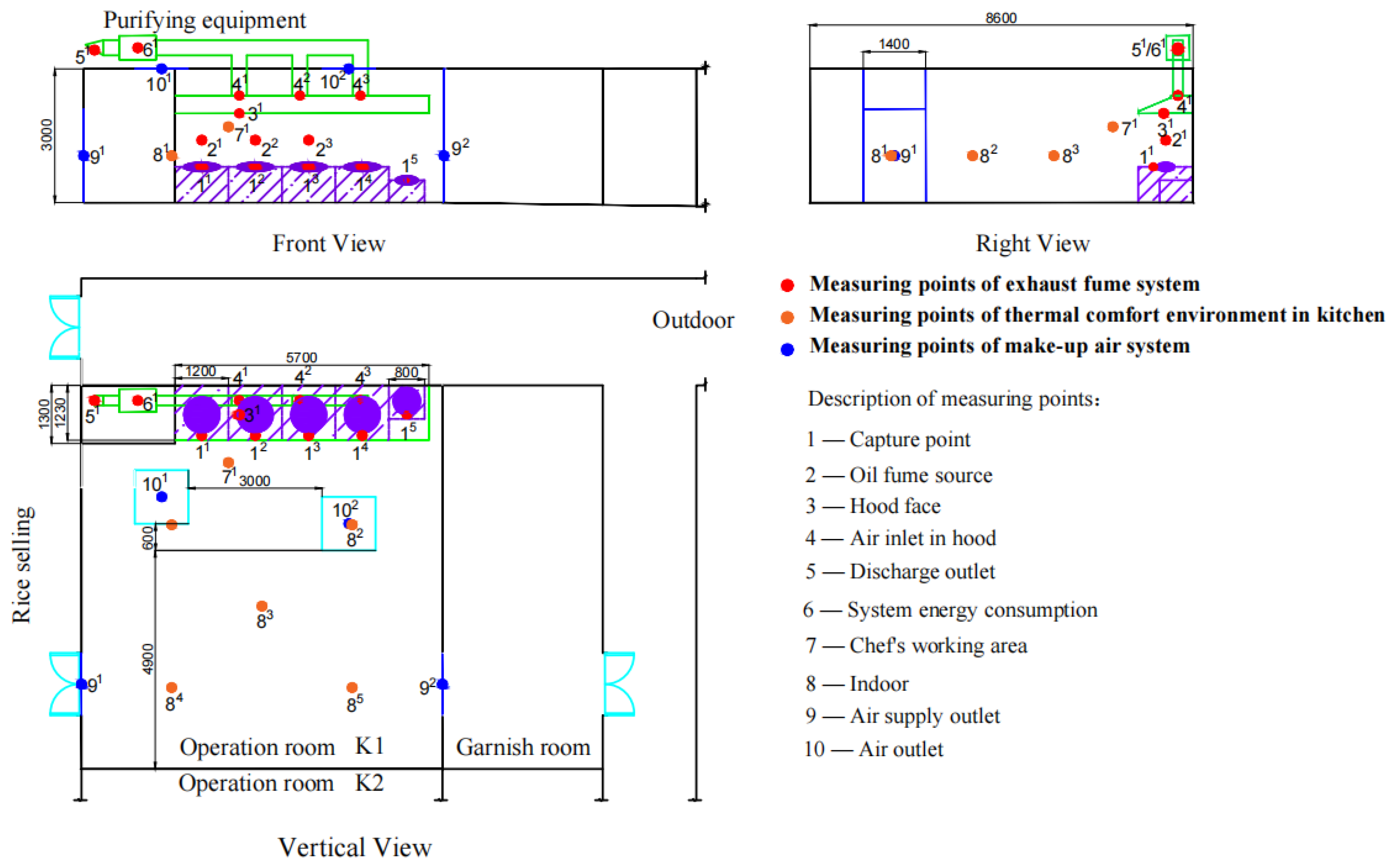

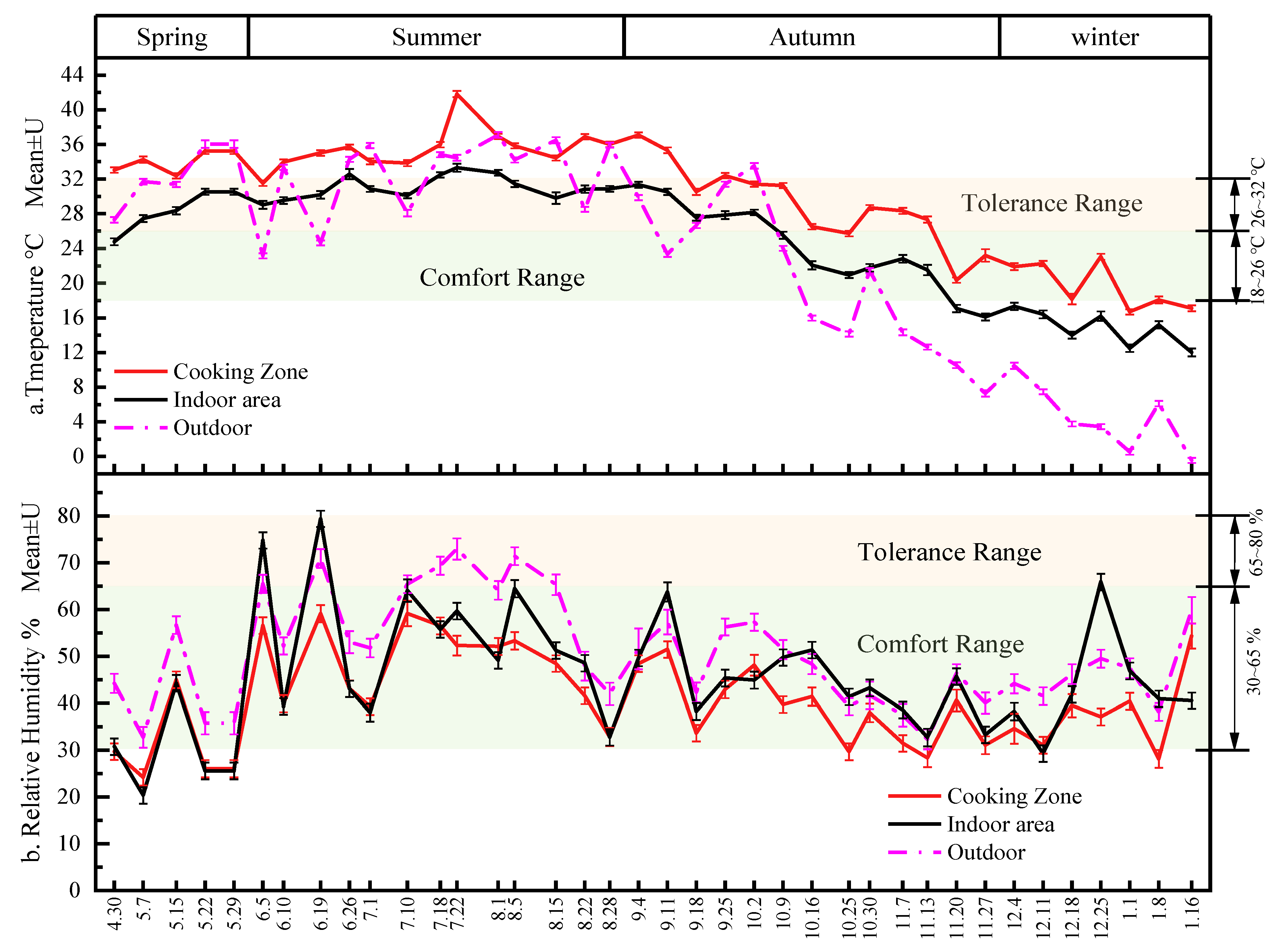

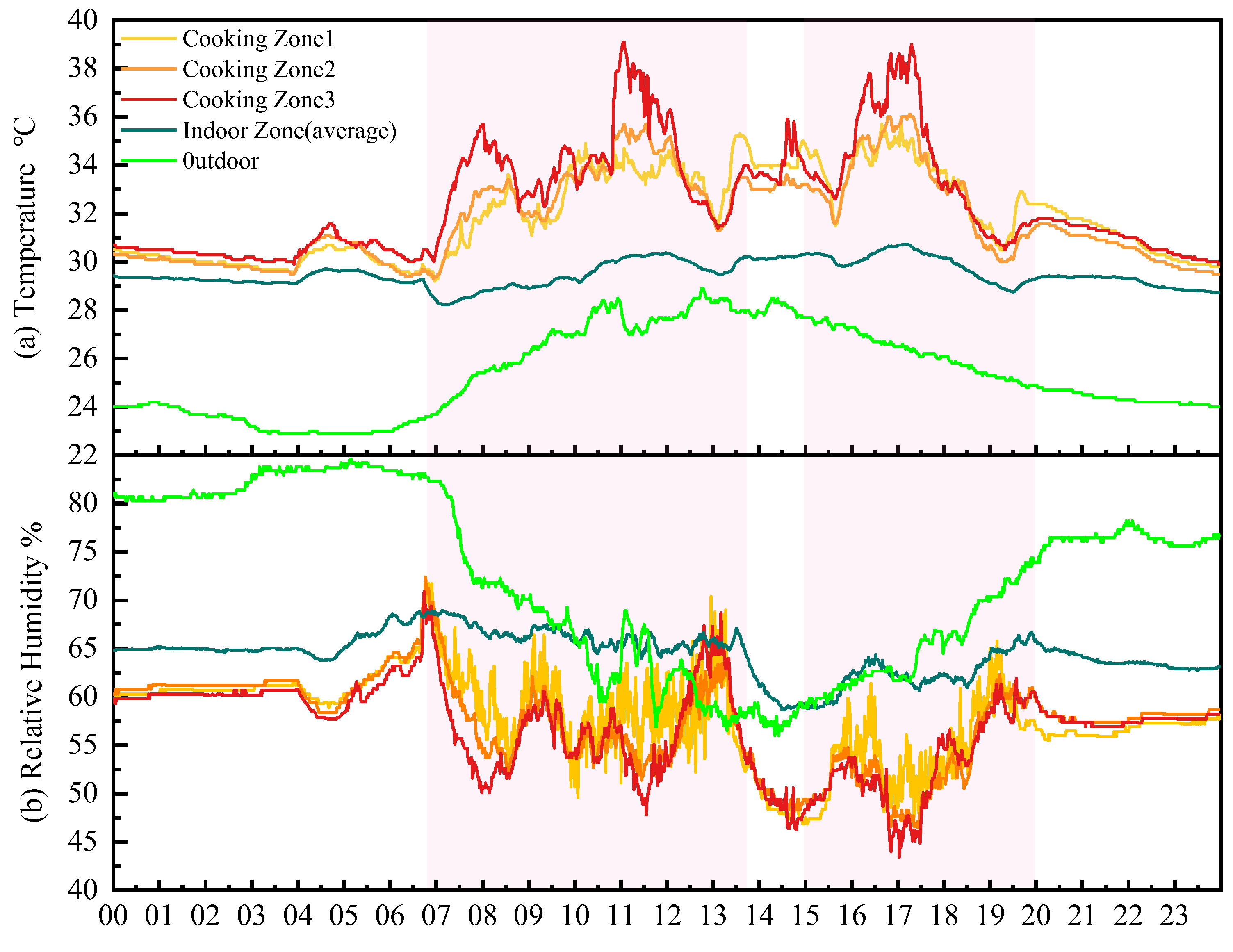

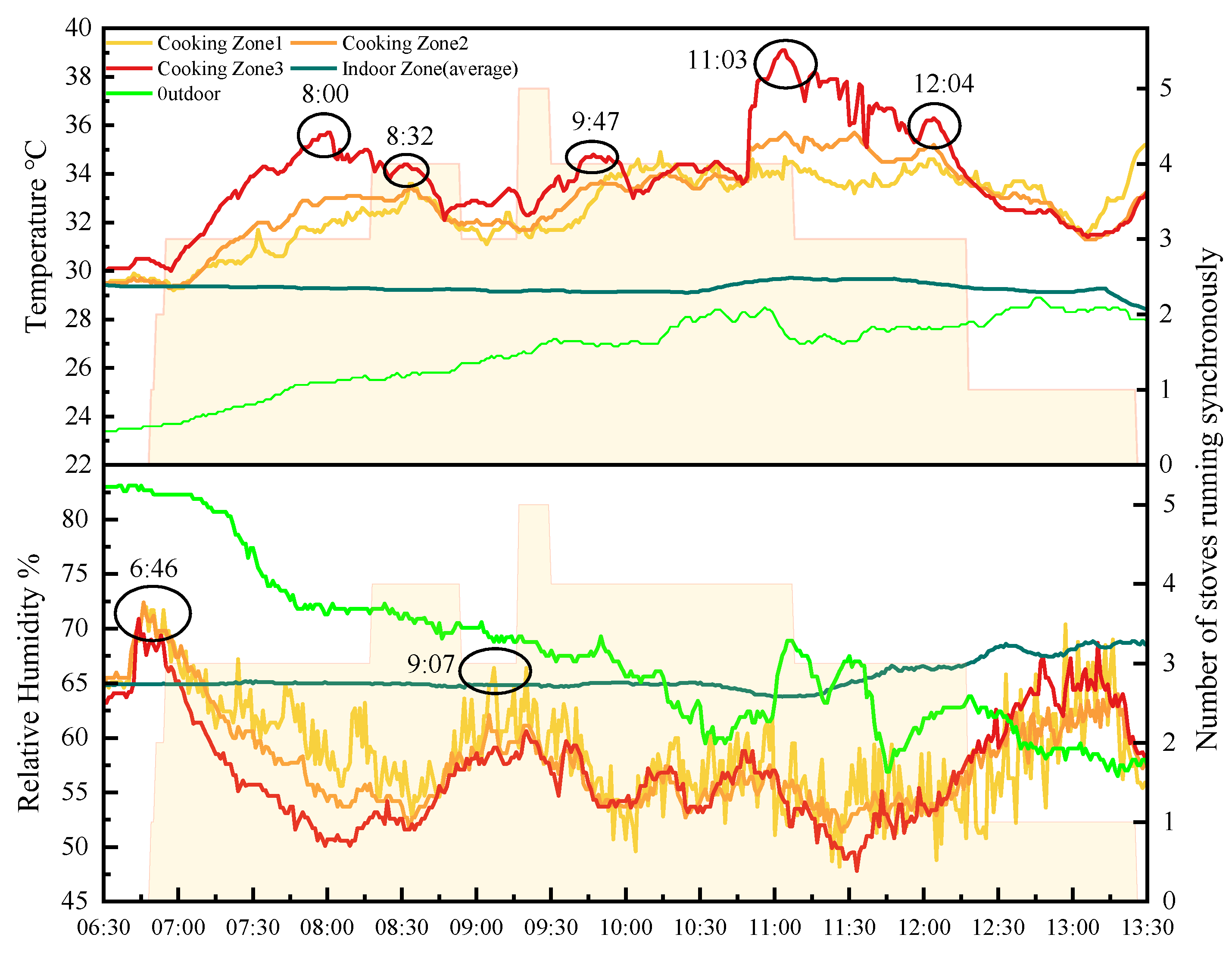
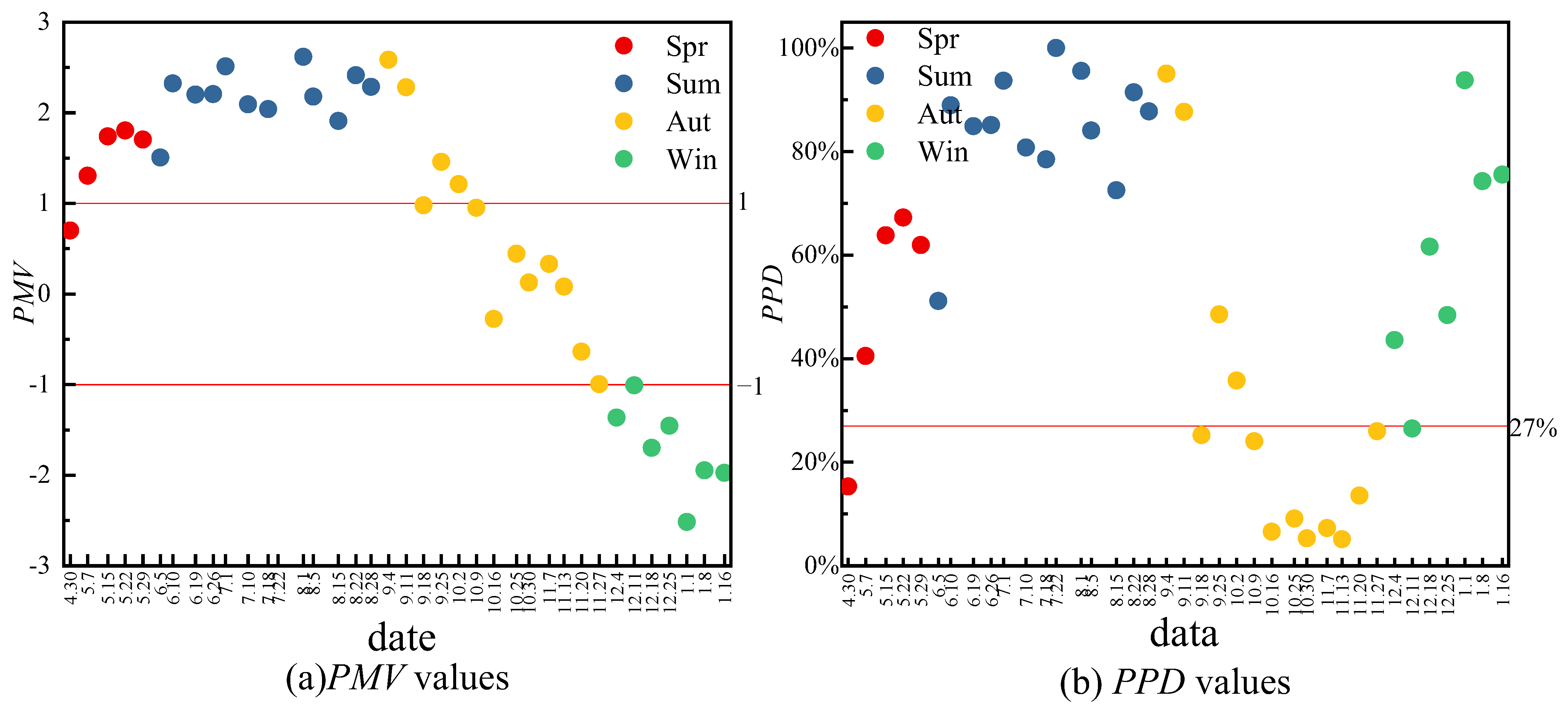
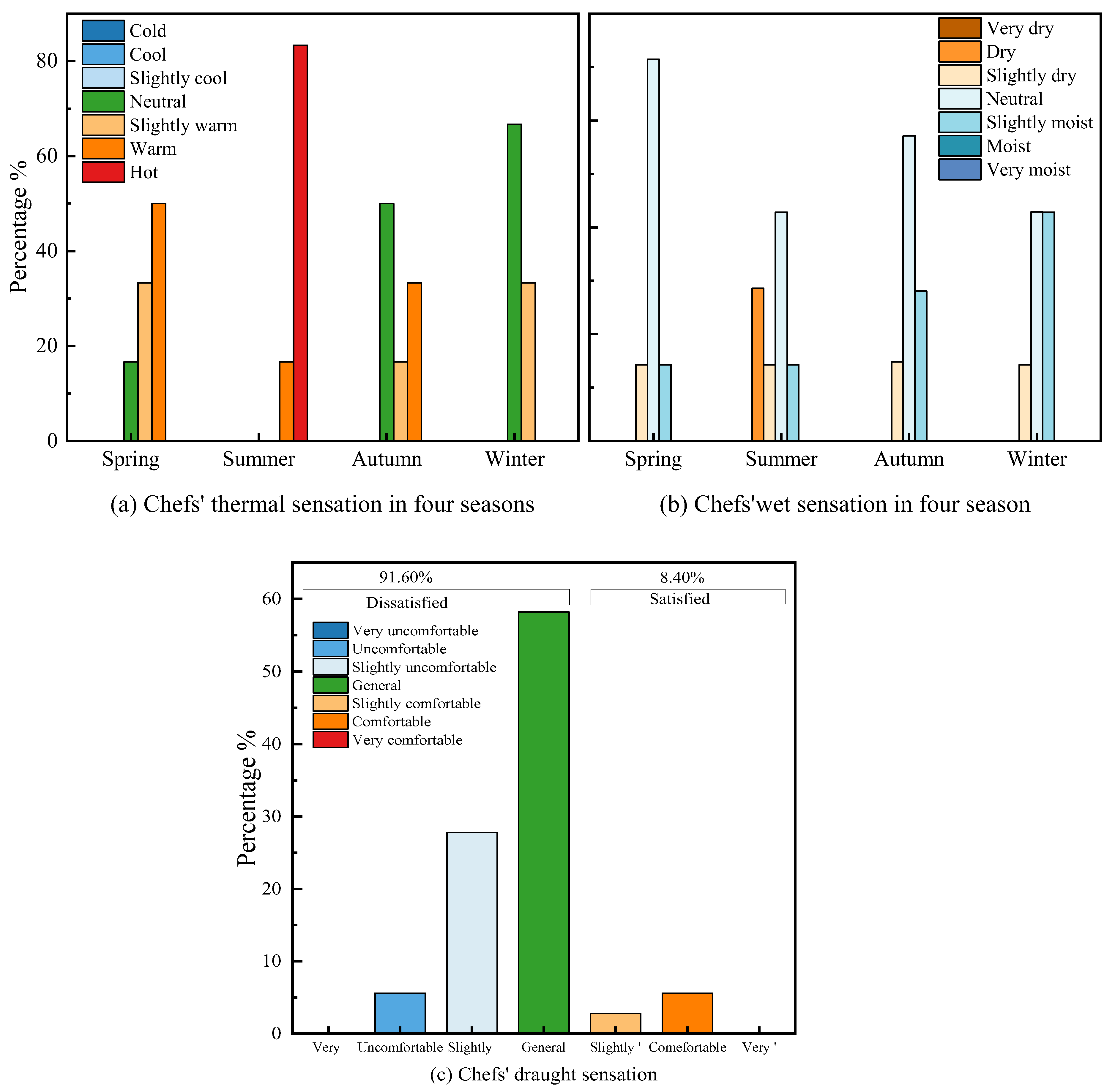
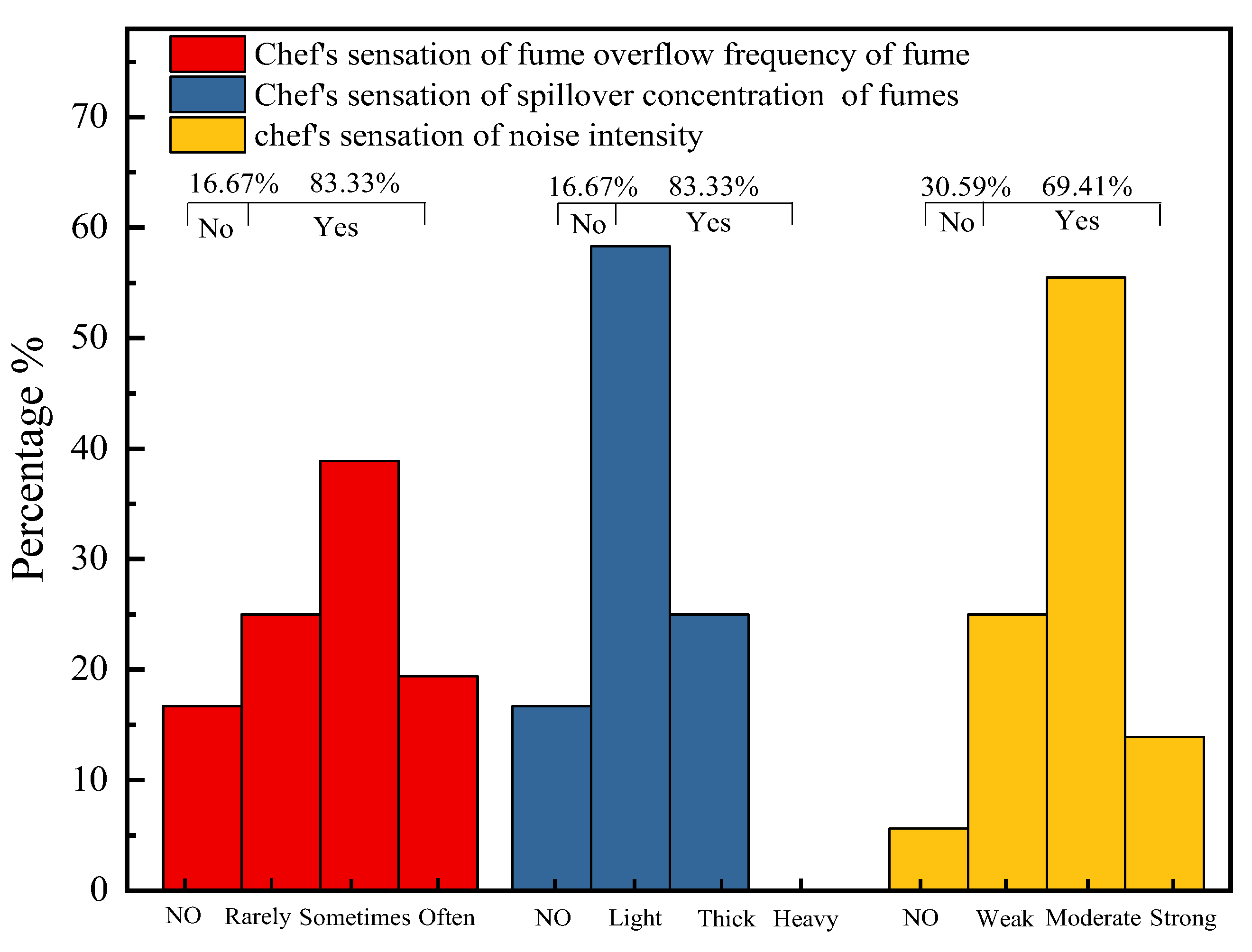
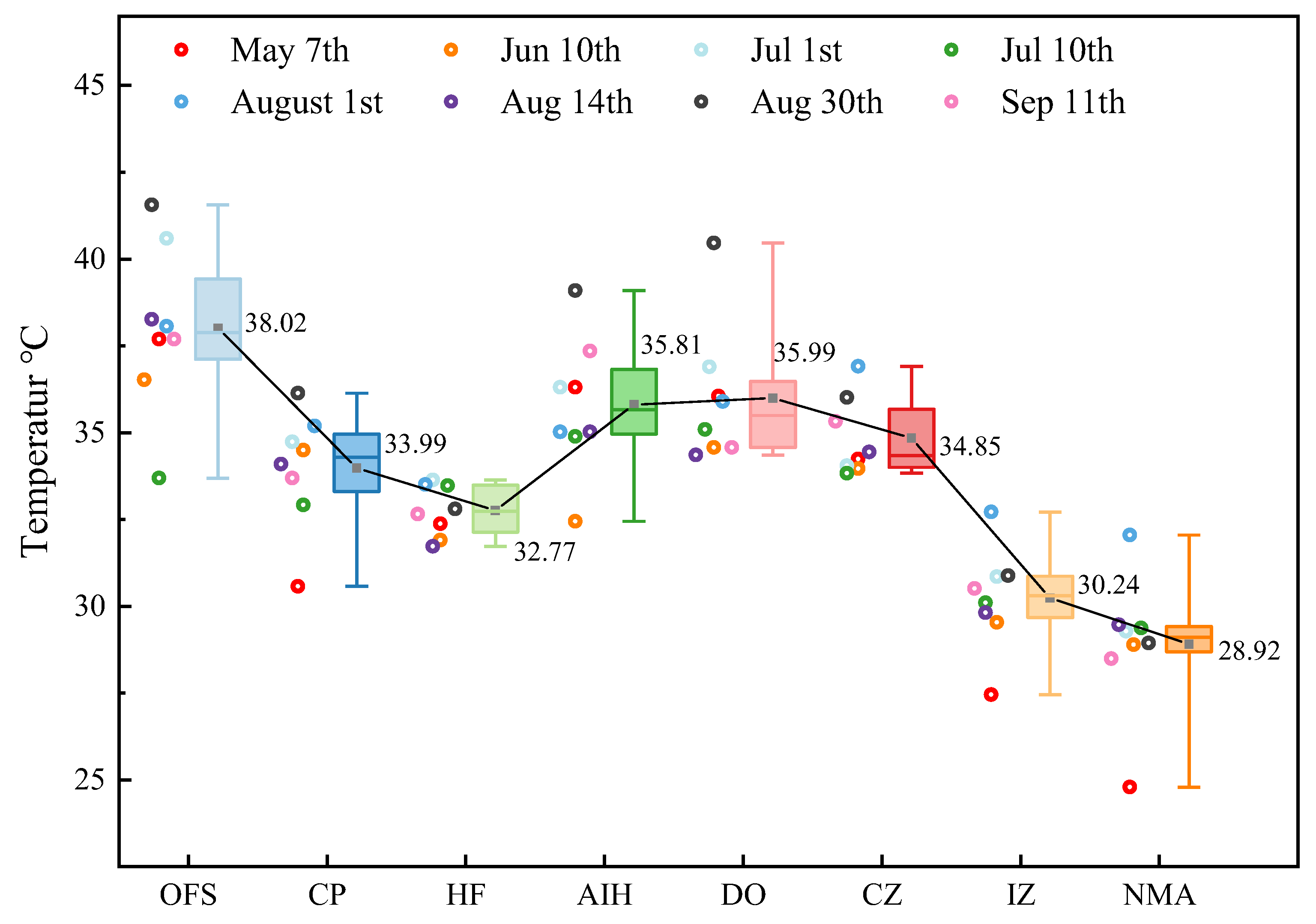
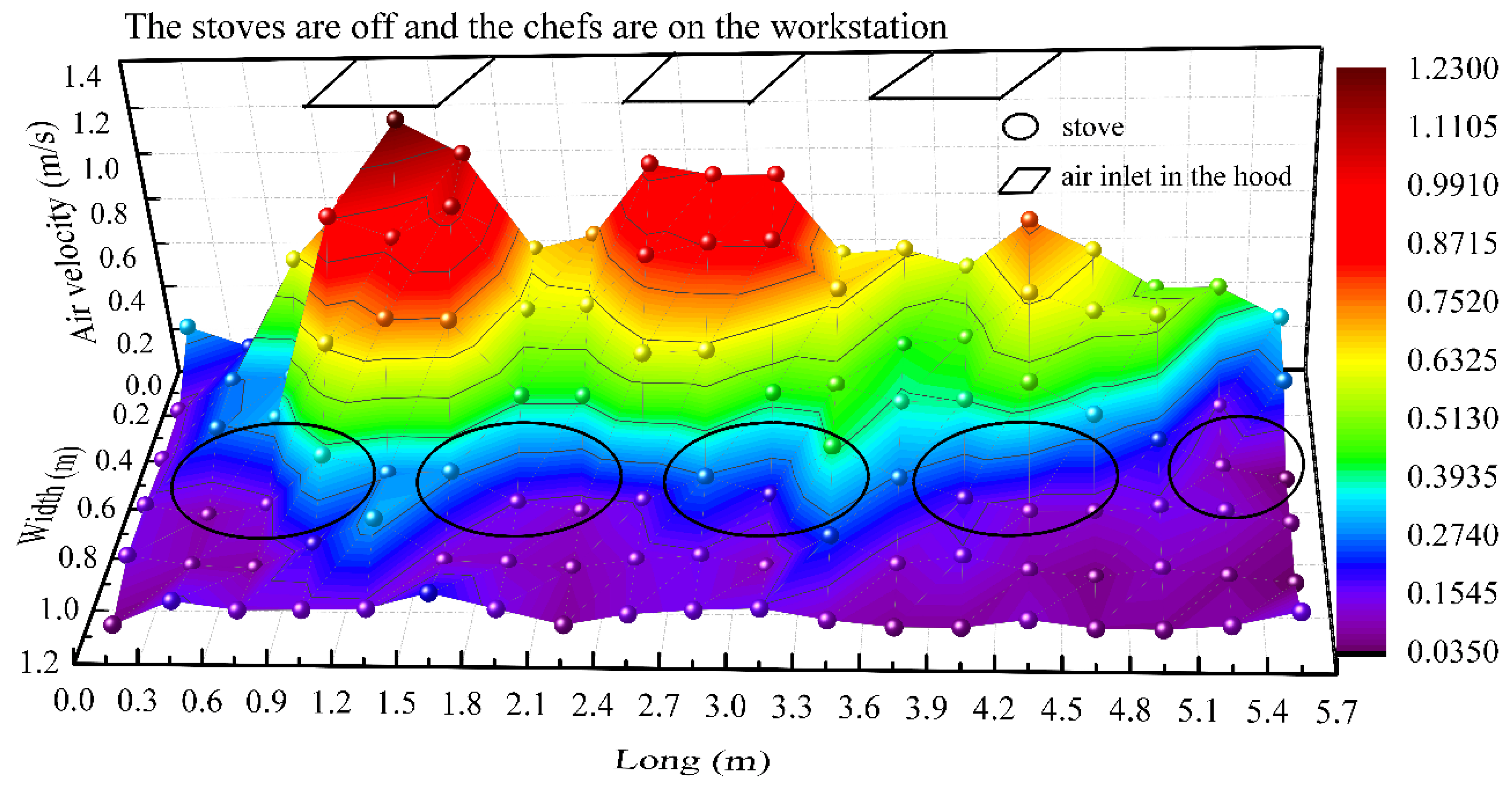
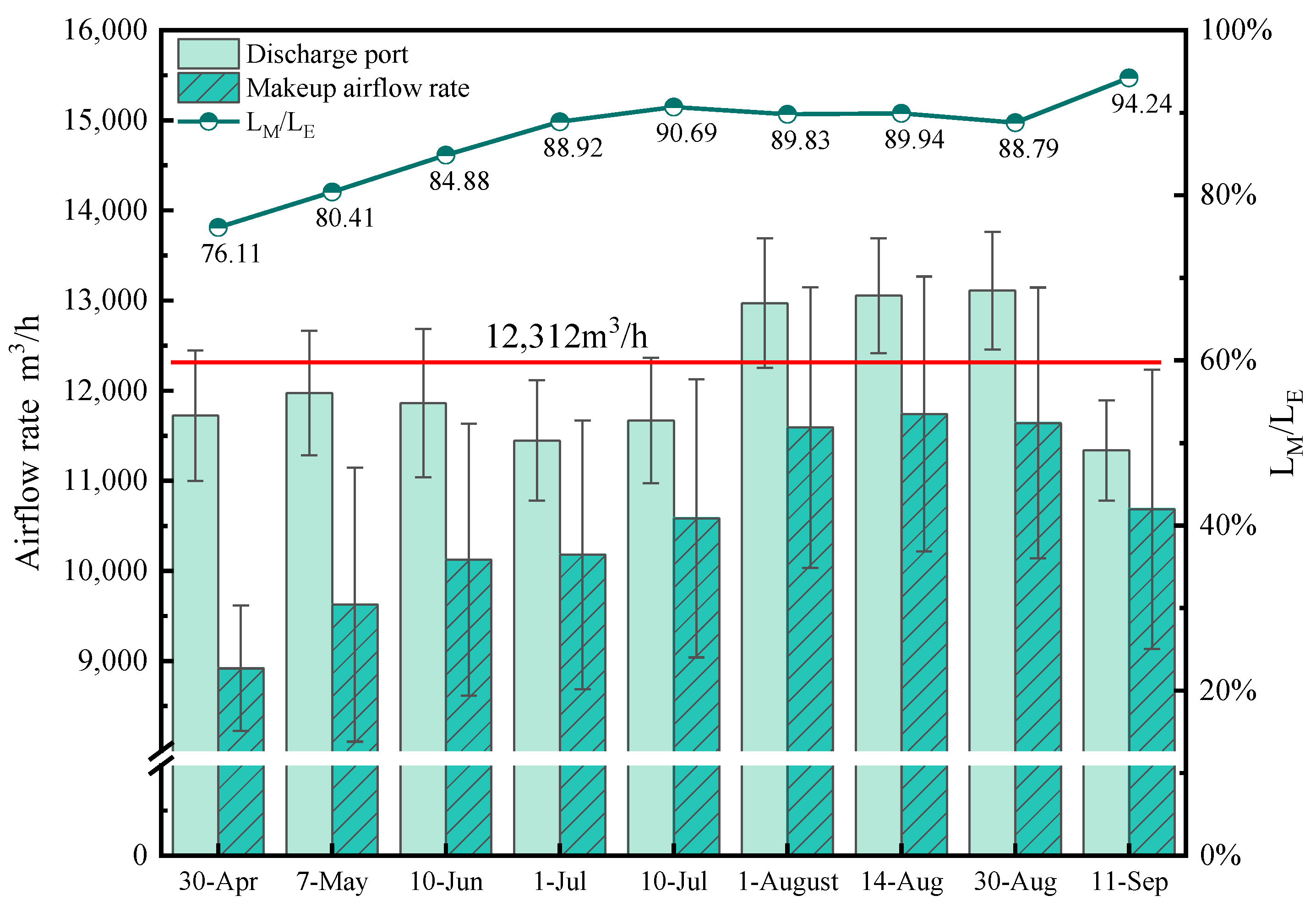
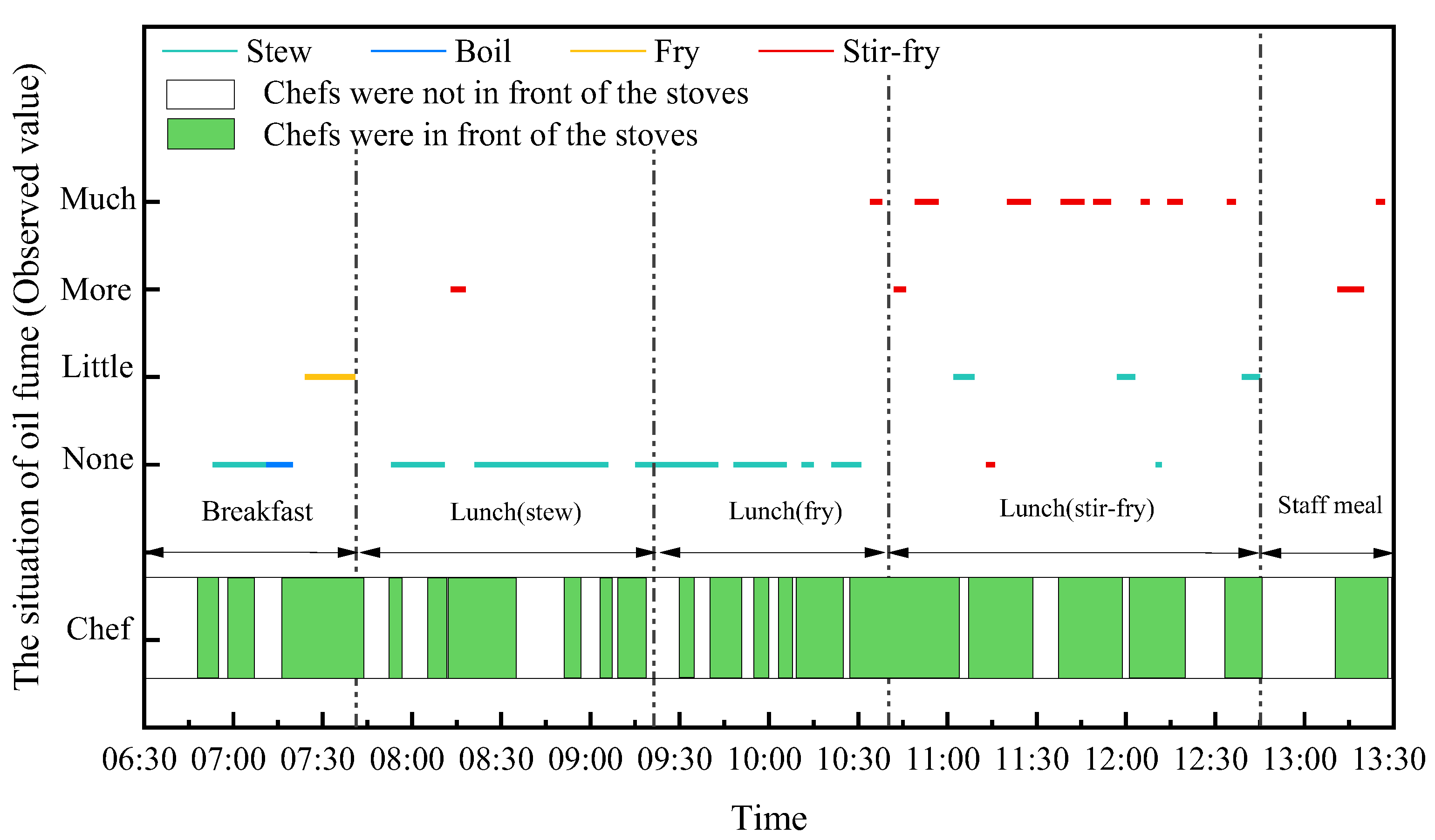
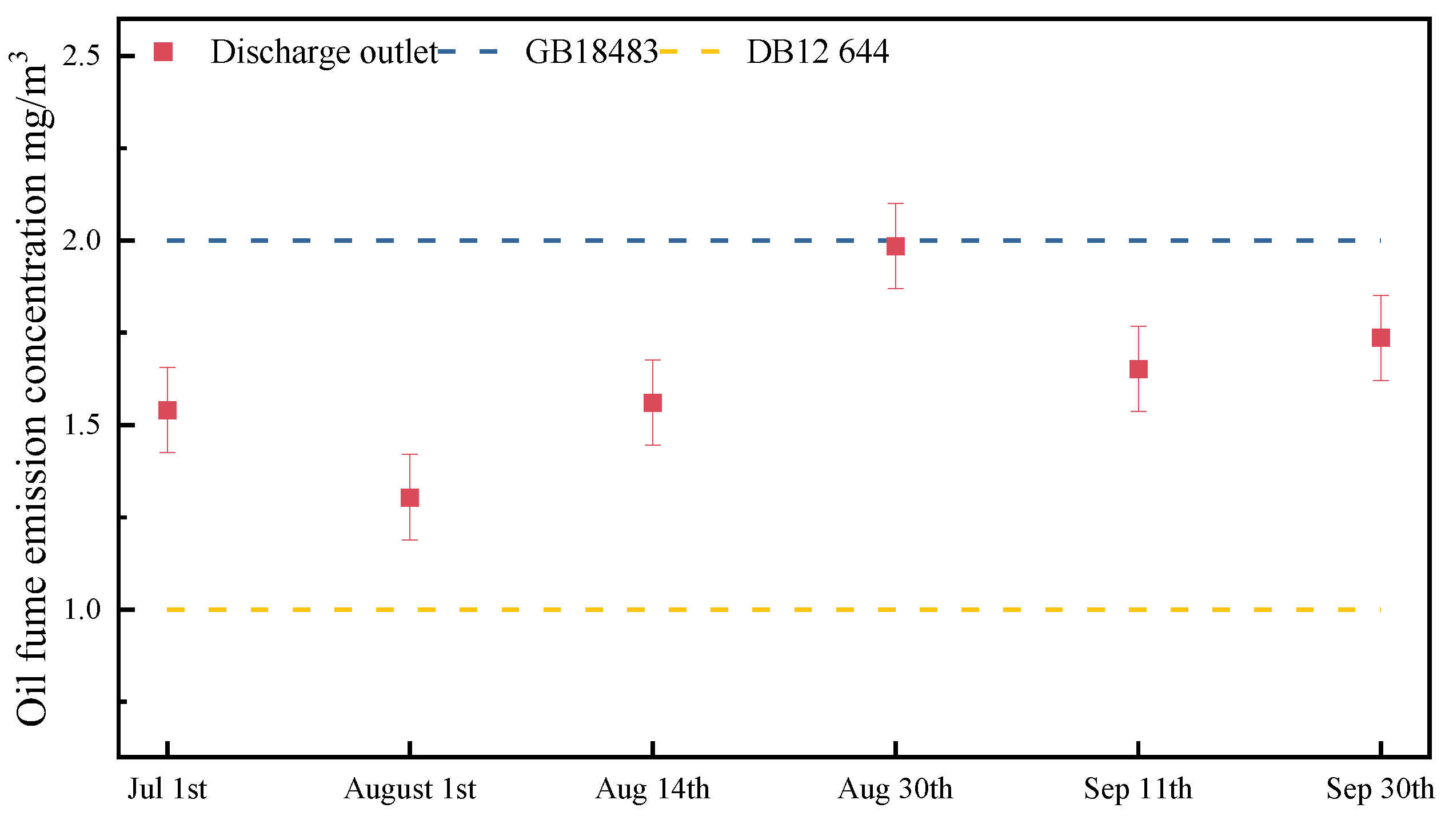
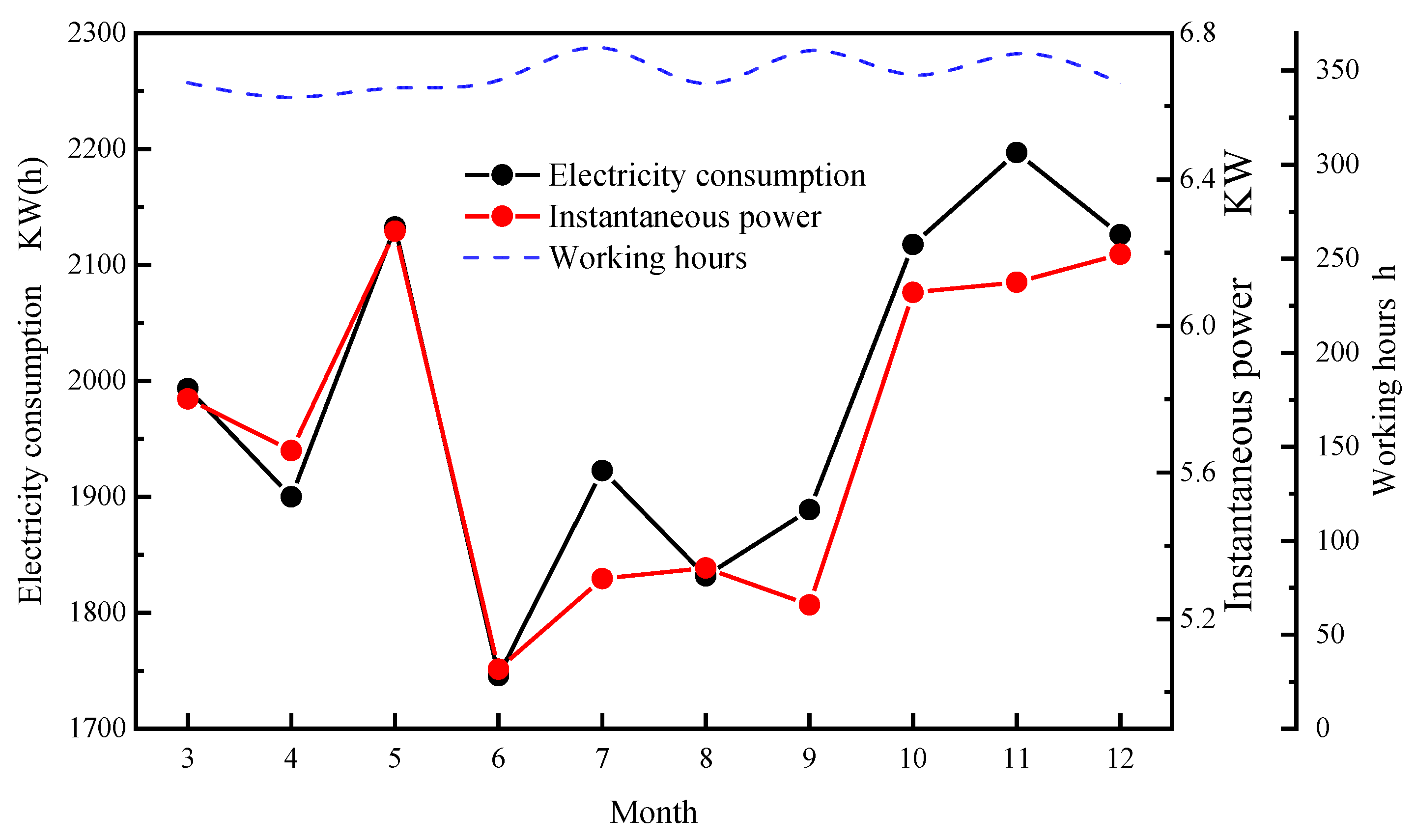
| Measuring Point | Parameter | Test Period | Sampling Time |
|---|---|---|---|
| Exhaust fume system | Velocity | Twice a month | 10 s |
| Temperature | Twice a month | 10 s | |
| Oil fume concentration | Twice a month | 10 min | |
| Energy consumption | Continuous | 1 s | |
| Indoor environment and make-up air system | Velocity | Twice a month | 10 s |
| Temperature | 1 day per week | 1 s | |
| Humidity | 1 day per week | 1 s | |
| Outdoor environmental | Temperature | 1 day per week | 1 s |
| Humidity | 1 day per week | 1 s |
| Name | Model | Parameters | Range | Precision |
|---|---|---|---|---|
| Hot-wire Anemometer | Testo 405i | Temperature | −20 ± 60 °C | ±0.5 °C |
| Velocity | 0–30 m/s | ±(0.1 m/s + 0.5% Measured value) (0–2 m/s) ±(0.3 m/s + 0.5% Measured value) (2–15 m/s) | ||
| Temperature and Humidity Recorder | RC-4HA/C | Temperature | −30 ± 60 °C | ±0.5 °C |
| Humidity | 0–99% RH | ±0.3% RH | ||
| Microcomputer Oil Fume sampler | TH-880F(O2) | Oil fume emission concentration | Sample flow rate: 5–60 L/min | Inaccuracy ≤ ±2.5% |
| Infrared Spectrophotometer | JLBG-126U | Oil fume emission concentration | 2, 5, 20, 50, 100 mg/L | 2, 5, 20 mg/L ≤ ± 10% 50 mg/L ≤ ±5% 100 mg/L ≤ ±2% |
| Electricity Recorder | EX300 | Energy consumption | Voltage: 15–500 V Current: 0.01–5 A | Current: ±0.2% FS Voltage: ±0.2% FS Electricity: ±0.5% FS |
| Number of Chefs | Percentage (%) | |
|---|---|---|
| Gender | ||
| Male | 27 | 75.00 |
| Female | 9 | 25.00 |
| Age | ||
| 16–20 | 9 | 25.00 |
| 21–30 | 16 | 44.44 |
| 31–40 | 5 | 13.89 |
| ≥41 | 6 | 16.67 |
| Hight (cm) | ||
| 150–160 | 7 | 19.44 |
| 161–170 | 14 | 38.89 |
| 171–180 | 14 | 38.89 |
| ≥181 | 1 | 2.78 |
| Stove | Dishes Name | |||||
|---|---|---|---|---|---|---|
| 8:00 | 9:07 | 12:04 | 8:32 | 9:47 | 11:03 | |
| 3 | 4 | |||||
| No.1 | Stir-fry noodles | Mapo tofu | Stir-fry potato chips | Stir-fry cabbage | Stewed chick with mushroom | Stir-fry beans |
| No.2 | Stir-fry rice with egg | Boil water | Stir-fry cabbage | Braised meat | Stir-fry pork with green pepper | Stir-fry chicken |
| No.3 | Thaw meat | Cooking soup | Stir-fry cabbage | Cooking soup | Cooking soup | Fry fish |
| No.4 | Off | Off | Off | Thaw meat | Fry fish | Stir-fry cabbage |
| No.5 | Off | Off | Off | Off | Off | Off |
| Measuring Points | Capture Point | Hood Face | Air Inlet in the Hood | Natural Makeup Air Outlet | |||||||
|---|---|---|---|---|---|---|---|---|---|---|---|
| 11 | 12 | 13 | 14 | 15 | 3 | 41 | 42 | 43 | 91 | 92 | |
| Standard Value | 0.25–0.5 m/s [40] | ≥0.5 m/s [20] | 4–5 m/s [20] | ≤1 m/s [20] | |||||||
| 30-Apr | 0.55 | 0.66 | 0.68 | 0.47 | 0.17 | 0.35 | 11.41 | 9.10 | 7.00 | 0.66 | 0.21 |
| ±U | 0.06 | 0.07 | 0.07 | 0.06 | 0.07 | 0.07 | 0.25 | 0.18 | 0.14 | 0.06 | 0.01 |
| 7-May | 0.50 | 0.57 | 0.63 | 0.55 | 0.21 | 0.40 | 12.86 | 8.77 | 6.73 | 0.67 | 0.19 |
| ±U | 0.06 | 0.06 | 0.06 | 0.06 | 0.06 | 0.06 | 0.17 | 0.11 | 0.13 | 0.06 | 0.06 |
| 10-Jun | 0.53 | 0.46 | 0.45 | 0.52 | 0.36 | 0.44 | 11.90 | 8.21 | 7.06 | 0.70 | 0.20 |
| ±U | 0.09 | 0.07 | 0.06 | 0.07 | 0.06 | 0.06 | 0.15 | 0.15 | 0.08 | 0.06 | 0.06 |
| 1-Jul | 0.43 | 0.45 | 0.43 | 0.46 | 0.29 | 0.40 | 12.09 | 8.39 | 6.73 | 0.78 | 0.31 |
| ±U | 0.06 | 0.07 | 0.08 | 0.06 | 0.07 | 0.06 | 0.18 | 0.22 | 0.08 | 0.06 | 0.06 |
| 10-Jul | 0.52 | 0.46 | 0.55 | 0.52 | 0.12 | 0.35 | 11.78 | 8.71 | 6.95 | 0.57 | 0.32 |
| ±U | 0.06 | 0.06 | 0.07 | 0.06 | 0.06 | 0.06 | 0.20 | 0.29 | 0.10 | 0.06 | 0.06 |
| 1-Aug | 0.54 | 0.40 | 0.58 | 0.50 | 0.11 | 0.35 | 11.87 | 8.74 | 6.98 | 0.64 | 0.34 |
| ±U | 0.06 | 0.06 | 0.07 | 0.07 | 0.06 | 0.06 | 0.14 | 0.19 | 0.17 | 0.06 | 0.06 |
| 14-Aug | 0.52 | 0.51 | 0.50 | 0.52 | 0.22 | 0.35 | 12.04 | 8.56 | 7.34 | 0.70 | 0.31 |
| ±U | 0.06 | 0.06 | 0.06 | 0.06 | 0.06 | 0.06 | 0.21 | 0.17 | 0.10 | 0.06 | 0.06 |
| 30-Aug | 0.48 | 0.53 | 0.51 | 0.46 | 0.19 | 0.35 | 11.98 | 9.04 | 6.35 | 0.69 | 0.31 |
| ±U | 0.06 | 0.06 | 0.07 | 0.09 | 0.06 | 0.06 | 0.15 | 0.14 | 0.13 | 0.06 | 0.06 |
| 11-Sep | 0.53 | 0.46 | 0.42 | 0.42 | 0.22 | 0.36 | 11.95 | 8.69 | 6.60 | 0.73 | 0.22 |
| ±U | 0.09 | 0.07 | 0.06 | 0.06 | 0.06 | 0.06 | 0.17 | 0.09 | 0.20 | 0.06 | 0.06 |
Publisher’s Note: MDPI stays neutral with regard to jurisdictional claims in published maps and institutional affiliations. |
© 2022 by the authors. Licensee MDPI, Basel, Switzerland. This article is an open access article distributed under the terms and conditions of the Creative Commons Attribution (CC BY) license (https://creativecommons.org/licenses/by/4.0/).
Share and Cite
Deng, N.; Fan, M.; Hao, R.; Zhang, A.; Li, Y. Field Measurements and Analysis on Temperature, Relative Humidity, Airflow Rate and Oil Fume Emission Concentration in a Typical Campus Canteen Kitchen in Tianjin, China. Appl. Sci. 2022, 12, 11755. https://doi.org/10.3390/app122211755
Deng N, Fan M, Hao R, Zhang A, Li Y. Field Measurements and Analysis on Temperature, Relative Humidity, Airflow Rate and Oil Fume Emission Concentration in a Typical Campus Canteen Kitchen in Tianjin, China. Applied Sciences. 2022; 12(22):11755. https://doi.org/10.3390/app122211755
Chicago/Turabian StyleDeng, Na, Mengke Fan, Ruisen Hao, Awen Zhang, and Yang Li. 2022. "Field Measurements and Analysis on Temperature, Relative Humidity, Airflow Rate and Oil Fume Emission Concentration in a Typical Campus Canteen Kitchen in Tianjin, China" Applied Sciences 12, no. 22: 11755. https://doi.org/10.3390/app122211755
APA StyleDeng, N., Fan, M., Hao, R., Zhang, A., & Li, Y. (2022). Field Measurements and Analysis on Temperature, Relative Humidity, Airflow Rate and Oil Fume Emission Concentration in a Typical Campus Canteen Kitchen in Tianjin, China. Applied Sciences, 12(22), 11755. https://doi.org/10.3390/app122211755






